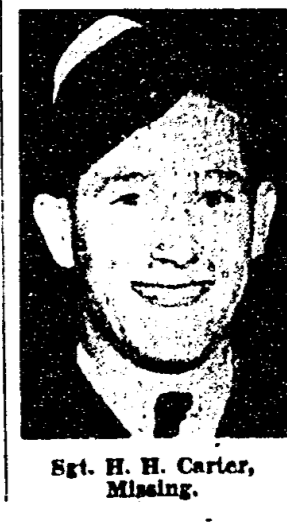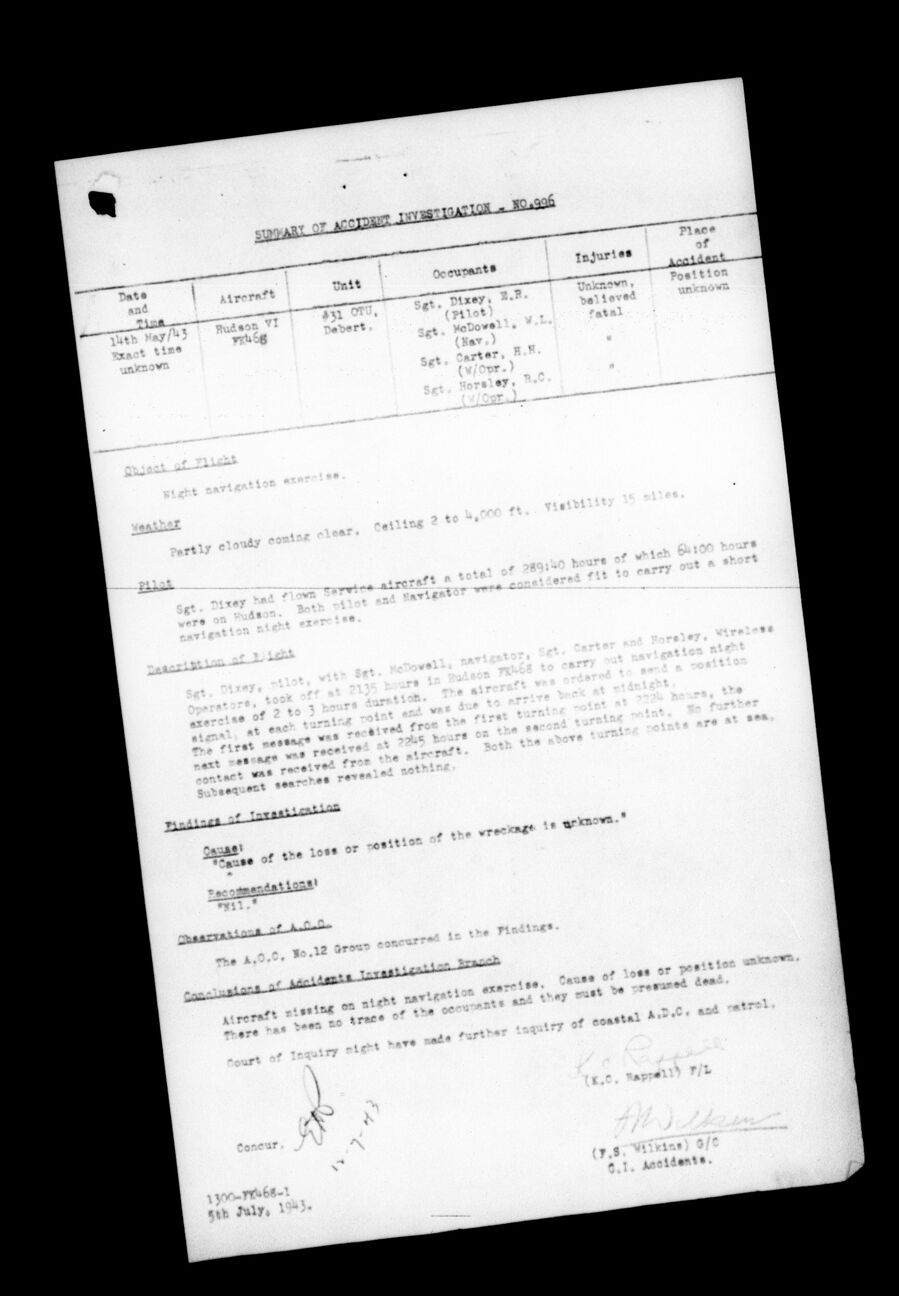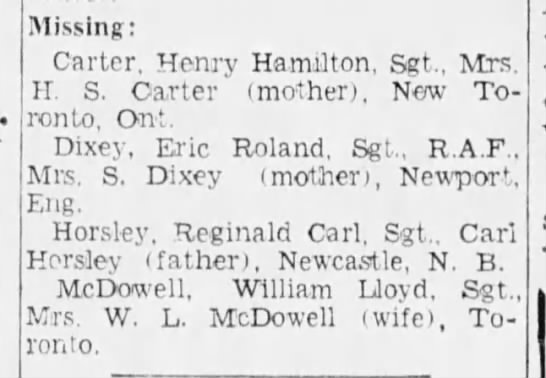


September 26, 1921 - May 15, 1943



Henry Hamilton Carter, born in Hamilton, Ontario, was the son of Harold Stanley Carter, labourer at Goodyear Tire Corp., and Jenny (nee McConnell) Carter of Mimico, Ontario. He had two sisters, Mrs. James Duffy and Miss Jean Carter, of New Toronto, Ontario. The family attended the United Church. [His birth date could have been September 28, 1922, as his mother wrote this date on the estates form.]
Henry enjoyed hockey, skiing, and marathon running, plus swimming; his hobby was marksmanship and motor mechanics.
Henry was a Goodyear Tire and Rubber worker prior to enlistment. He had taken night school in 1939 studying shorthand, typing and bookkeeping. He had grey eyes and fair hair, stood 5’ 9 ¼” tall and weighed 157 pounds. “Good-athletic physique. Standard mentality. ½” scar across bridge of nose centre. A well-developed, athletic lad, eager, pleasant, courageous, tenacious, excellent reactions. Average intelligence, co-operative. Night visual acuity above average.” On his interview sheet: “Minimum education but will work hard on course. Good marksmanship with rifle medals.”
He started his journey through the BCATP at No. 1 Manning Depot, Toronto April 15, 1942. He was then sent to No. 1 Wireless School, Montreal on June 20 until July 3, 1942.
From there, he was sent to Guelph and No. 4 Wireless School until January 22, 1943. Here he was at the station hospital from August 19-21, 1942.
No. 1 B&G School, Jarvis, Ontario was his next stop from January 23 to March 5, 1943. He earned his Air Gunner’s Badge on February 22, 1943.
Henry was then sent to Eastern Air Command and No. 31 O.T.U., Debert, Nova Scotia.
Hudson VI FK468, 31 O.T.U. on May 15, 1943, with crew members WOAG, Sgt. Henry Hamilton Carter, First Pilot, Sgt. Eric Rowland Dixey, 1339314, RAF, WOAG Sgt. Reginald Carl Horsley, R165006, and Navigator, Sgt. William Lloyd McDowell, R153587, RCAF went out on a night navigation exercise. The last message was received at 2245 hours on the second turning point -- both turning points were at sea. No further contact.
A full Court of Inquiry was held between May 19 and 20, 1943. (Microfiche C5937, image 3967). Eleven witnesses were called.
The first witness, F/L Charles Raymond Tufford, 41335, OC No. 2 Squadron, No. 31 O.T.U. stated, “Sgt Dixey and his crew commenced training in ‘C’ flight No. 2 Squadron on 3.5.43. Sgt. Dixey had completed 42 hours, 35 minutes in No. 1 Conversion Squadron on Hudson aircraft and approximately 18 ½ hours in my squadron before being reported missing. Of this time, 5 hours 50 minutes is dual and solo night flying circuits and landings. This crew had completed two day trips and was considered fit for a short navigation night exercise of 2-3 hours duration. On night of 14.5.43, he was detailed to carry out exercise Route 3 and took off at 2100 hours. I was informed at approximately 0830 hours 15.5.43 that the aircraft FK468 was missing and that a search had already been instigated. This crew’s progress in the squadron had been quite satisfactory. The dinghy and parachute drill is carried out by Ground Instruction school prior to entering No. 2 Squadron. The pilot was fully conversant with the cockpit drill and fuel system.”
The second witness, WO Joseph Maurice Smart, RAF stated that he was duty Instructor in No. 2 Squadron. “At approximately 30.40 I authorized Sgt Dixey as Captain of Aircraft No. FK468 to carry out Navigation Exercise No. 3 to take off at 2100 hours, with the following crew: McDowell, Carter, and Horsley. The aircraft took off at 2100 hours and was due to return at approximately 2359 but failed to return. I was asked by S/L Womersley at 0500 to organize three crews and three aircraft for a search for this aircraft to take off at 0630 hours on 15.5.43. I carried this out and sent off duty at about 0900 hours. I realize that this crew had completed their training up to the point where they were fit to do a short night cross country trip.”
The third witness, F/L John Edward Shannon, Controller Operations Room, stated that he “ascertained there were five aircraft to take off on a navigation exercise No, 3 starting at 2100 hours. Aircraft FK468 was given W/T go at 2135. This aircraft was ordered to send a position signal at each turning point and was due to arrive back by midnight. We received the first message sent from the first turning point at 22.24 hours. The message was received at 22.45 hours, i.e. three minutes after ETA at second turning point. No further contact was made with this aircraft. I was notified by Filter Room at EAC that an unknown aircraft had been plotted circling Musquadoboit Harbour and later proceeding down coast towards Halifax. This plotting however, was lost at approximately 10-15 miles up the coast from Halifax. At approximately 0045 hours on 15.5.43, I took all necessary overdue action and went off duty at 1030 hours.” He had no knowledge of the crew but he had heard that Sgt. Dixey was an above average pilot. The exercise was to be carried out at 3,000 feet.
The fourth witness, F/O Angus Gordon Mackinnon, J15282, Controller, stated that the trip would have taken normally about 2 ½ hours. “The crews were ordered to send out an OK message every half hour and a position message at every turning point. I knew nothing about this crew.”
The fifth witness, S/L William Godfrey Tiley, RAF, stated that “Sgt Carter carried out 13 hours 25 minutes on training exercises using Bendix Equipment. He was assessed as above average as an air operator and in ground subjects. Sgt. Horsley carried out 9 hours 20 minutes on training exercises on the Bendix and was assessed as average on ground and air exercises.” Both WOAG were fully conversant with all safety facilities to be used in the event of emergency.
The sixth witness, F/O Edward Morris, RAF stated that the navigational ability of Sgt. McDowell was that “he had completed two daylight navigational exercises previously, neither exercise had shown any apparent difficulties and assessments on both exercises had been average. Apart from this to the best of my knowledge, he was a keen pupil.” When asked if all navigators originate any coded messages, he replied, “Yes, but he was a little slow in learning.”
The next set of witnesses testified to the airworthiness of the aircraft and the weather, which was favourable.
The conclusions: “Aircraft missing on night navigation exercise. Cause of loss or position unknown. There has been no trace of the occupants and they must be presumed dead. Court of Inquiry might have made further inquiry of coastal ADC and patrol.”
Henry had $420 in War Savings Certificates and $1725 in life insurance. The premiums would have been returned to his mother.